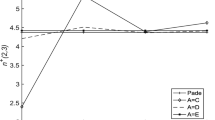Abstract
Renormalization or rescaling transformations generally produce more complicated interactions than are present in the initial Hamiltonian. After each rescaling it is necessary to truncate the Hamiltonian to make the next rescaling mathematically tractable. One is faced with the problem of choosing the coupling constants of the truncated Hamiltonian to obtain the best approximation. Following ideas of McMillan, we consider truncation procedures which give lower and upper bounds to the free energy. Conditions for optimal lower- and upper-bound truncations are derived. These optimal truncations are seen to yield exact results for the free energy in both the high- and low-temperature limits. Some of the problems inherent in all renormalization transformations that incorporate an optimal lower- or upper-bound truncation are discussed. Calculations for the twodimensional Ising model based on renormalization transformations which combine decimation and an optimal truncation are described. Even in the simplest approximation in which only nearest-neighbor interactions are retained the free energy is obtained to an accuracy of better than 1% for all temperatures if an optimal truncation rather than an ordinary truncation with no readjustment of the coupling constants is made. However, the simplest calculations involving optimal truncations are less successful in predicting derivatives of the free energy and critical exponents than the free energy itself.
Similar content being viewed by others
References
L. P. Kadanoff,Phys. Rev. Lett. 34:1005 (1975).
L. P. Kadanoff, A. Houghton, and M. C. Yalabik,J. Stat. Phys. 14:171 (1976).
L. P. Kadanoff,Ann. Phys. 100:359 (1976).
T. W. Burkhardt and E. Eisenriegler,Phys. Rev. B 17:318 (1978).
A. A. Migdal,Sov. Phys.-JETP 42:743 (1976).
M. Barber,J. Phys. A 10:1187 (1977).
W. van Saarloos, J. M. J. van Leeuwen, and A. M. M. Pruisken,Physica A 92:323 (1978).
S. J. Shenker, L. P. Kadanoff, and A. M. M. Pruisken, to be published.
W. L. McMillan, unpublished calculations.
L. P. Kadanoff and A. Houghton,Phys. Rev. B 11:377 (1975).
M. P. M. den Nijs and H. J. F. Knops, to be published.
L. Onsager,Phys. Rev. 65:117 (1944).
B. Kaufman and L. Onsager,Phys. Rev. 76:1244 (1949).
B. M. McCoy and T. T. Wu,The Two-Dimensional Ising Model (Harvard University Press, Cambridge, 1973).
P. G. Watson,J. Phys. C 1:575 (1968).
Author information
Authors and Affiliations
Rights and permissions
About this article
Cite this article
Burkhardt, T.W., Southern, B.W. Optimal truncation procedures in renormalization-group calculations. J Stat Phys 20, 247–257 (1979). https://doi.org/10.1007/BF01011937
Received:
Issue Date:
DOI: https://doi.org/10.1007/BF01011937



